|
By Donald H. Harrison
LA MESA, Calif.—Holocaust survivor Eve Gerstle had as her
houseguest last week the chairperson of the Active Museum of Jewish History,
which is based in her hometown of Wiesbaden,
Germany—the city from which she and her parents, Arthur and Sophie Wertheimer,
were deported by the Nazis in 1942 to the Czech ghetto of Terezin. Gerstle's
parents died of illness caused by unhealthful living conditions and
starvation in the ghetto.
Gerstle, 91, who is believed to be the last living survivor of the large group
of Jews who were deported from Wiesbaden on August 30, 1942, has been
acquainted for nearly two decades with museum chairperson Dorothee
Lottmann-Kaeseler, 62. The museum official, born in Krakow, is the daughter of a German
railroad engineer who was stationed in occupied Poland, and who disappeared at
the end of the war. The question of what her father did—and what his exact
role might have been in transporting Jews to their deaths—has haunted
Lottmann-Kaeseler most of her life. "He must have known," she says
grimly. Like many Germans of that age, her mother refused to discuss the
war with her.
Lottmann-Kaeseler came to the San Diego suburb of La
Mesa to carry out two missions. First, she presented a packet of
materials to Gerstle concerning the recent installation of a pair of
"stumbling stones" on the sidewalk in front of the house at Biebricher
Allee #33 where the Wertheimers had lived until their deportation. The stones
are not meant to be physically stumbled over, but rather are installed for
passersby to "mentally stumble upon," and be "made aware of the
many places where the people resided," Lottmann-Kaeseler said.
Artist Gunter Demnig conceived of the project memorializing German Holocaust
victims, and, more than 7,000 such stolpersteine thus far have been
placed throughout Germany. The names of the Wertheimers were chosen by
Bertram Theilacker, a banker with Nassauische Sparkasse who wanted to honor someone in his
profession. Arthur Wertheimer also had been a banker.
In a personal note that Lottmann-Kaeseler carried to Gerstle, Theilacker
explained that he wanted his two elementary school-aged children to understand
that in the Holocaust that no matter what a person's profession, he or she was
not immune from the Nazi tyranny. He said the Nazi crimes against Jews
were so "unfathomable, the children kept asking 'why, I cannot
understand.'" He said he felt it important to teach his children that
"democracy and tolerance don't fall from the sky, you have to work for
them."
The two children—Moritz, 10, and Nele, 7— also wrote notes to Gerstle,
telling her about their interests in sports and other activities and wishing her
health and long life.
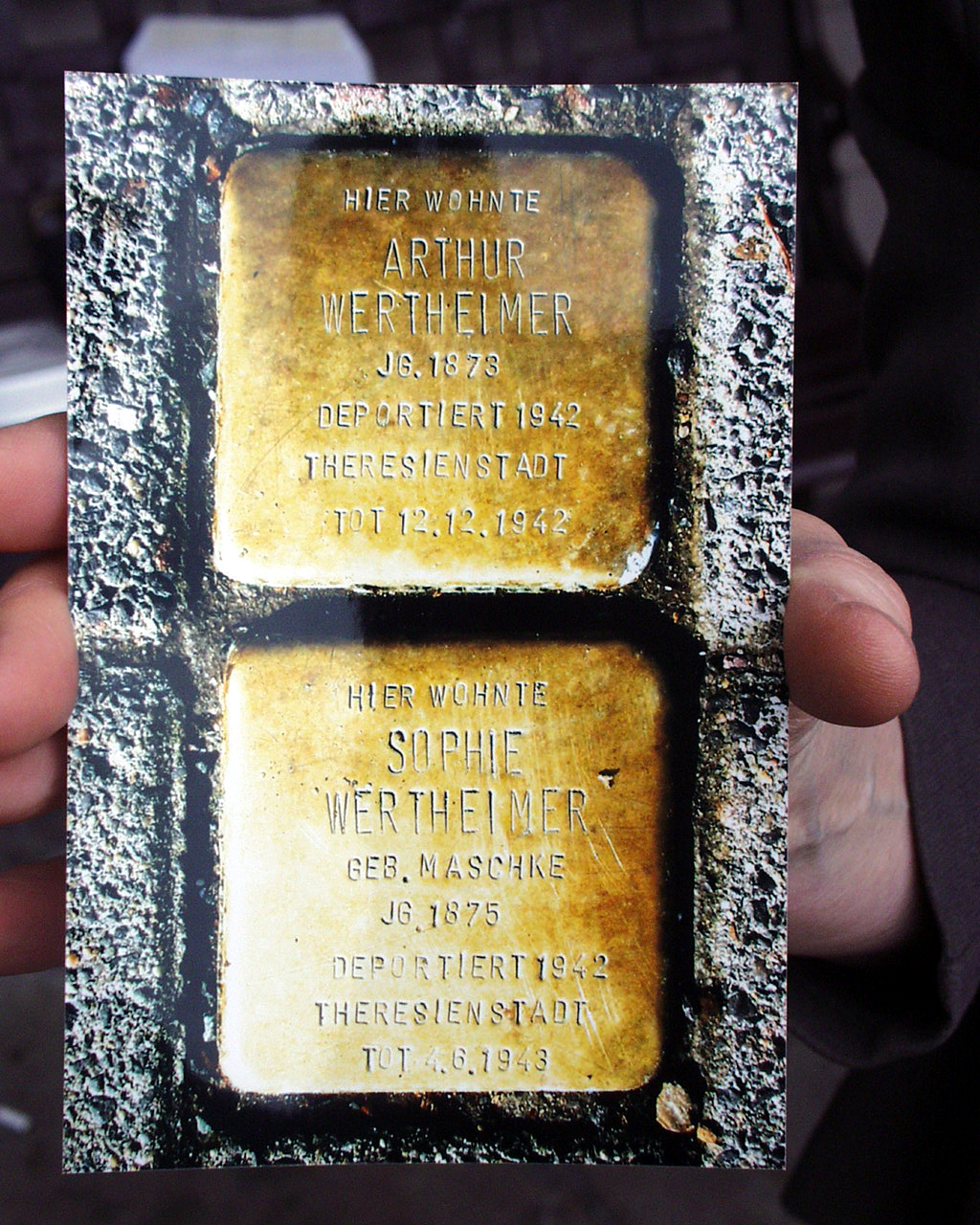
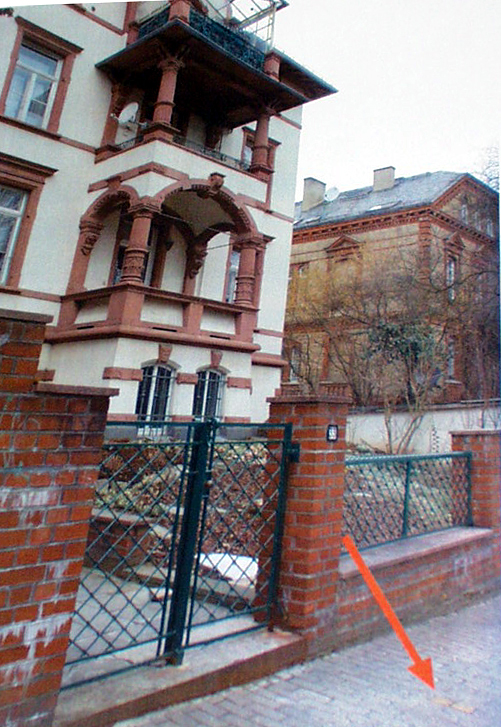
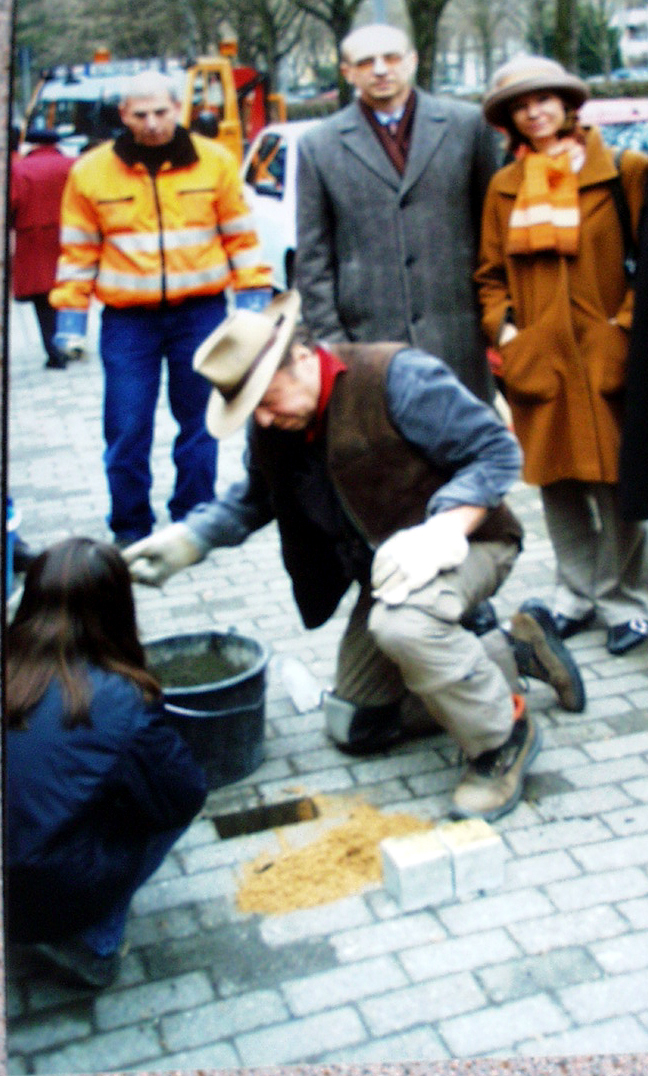
Photos brought to Eve Gerstle from Wiesbaden by Dorothee
Lottmann-Kaeseler show the stumbling stones created
in her parents' honor, telling their names, birth dates, the fact that they had
lived in the building shown in the second
photograph, that they had been deported to Theresienstadt (German name for
Terezin) and giving the dates of their
deaths. Arrow in second photo shows where the stumbling stones were
installed, and third photo shows artist Gunter
Demnig installing the stone. The man in topcoat behind him is Bertram.
Theilacker, the banker who not only paid for
the stones, but was able to convince his bank to donate funding for Lottmann-Kaeseler's research trip to the
U.S.A.
Gerstle previously
had been honored by the City of Wiesbaden with a gold medal
in recognition of the lecturing she has done about her
experiences in the Holocaust both in Germany and in the United States.
With Gerstle's 92nd birthday approaching April 20, Lottmann-Kaeseler's
second purpose for visiting her was to videotape her recollections of her life
in Wiesbaden before the deportation, and to learn what had happened to her
since.
I was privileged on Friday, March 31, to drive the two women to the Holocaust
Memorial Garden at the Lawrence Family Jewish Community Center where the names
of members of Gerstle's family are listed along with many other victims of the
Holocaust.

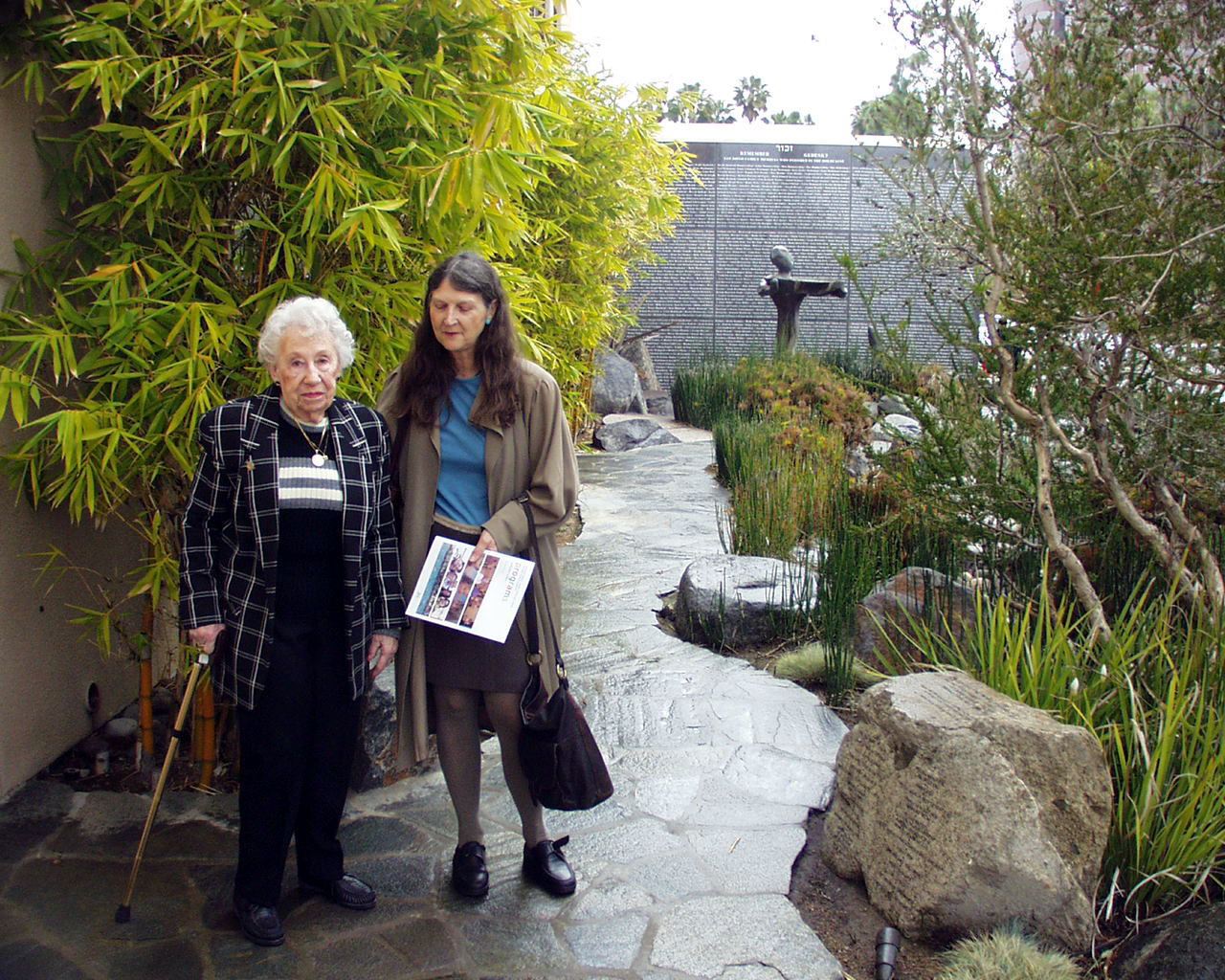 After
visiting the monument, Gerstle next took Lottmann-Kaeseler upstairs to the Astor
Judaica Library to see the Holocaust book collection, which was dedicated in
honor of Gerstle by Hal
and Eileen
Wingard. Gerstle will play an important role in the upcoming San Diego
Music Festival, which Eileen Wingard has helped to organize. Gerstle and San
Diego residents Margot Cohn, Lilli Greenberg and Ruth Sax will tell of their
personal experiences in Terezin in a panel presentation at 7:30 p.m., Tuesday,
May 16, at the Lawrence Family JCC in La Jolla. After
visiting the monument, Gerstle next took Lottmann-Kaeseler upstairs to the Astor
Judaica Library to see the Holocaust book collection, which was dedicated in
honor of Gerstle by Hal
and Eileen
Wingard. Gerstle will play an important role in the upcoming San Diego
Music Festival, which Eileen Wingard has helped to organize. Gerstle and San
Diego residents Margot Cohn, Lilli Greenberg and Ruth Sax will tell of their
personal experiences in Terezin in a panel presentation at 7:30 p.m., Tuesday,
May 16, at the Lawrence Family JCC in La Jolla.
The panel discussion was organized in connection with a recital to be performed
on the preceding evening by violinist Zina
Schiff entitled "Music Played in Terezin." The performance
will include pieces performed by inmate violinist Karel Frölich in the concentration
camp, which the Nazis maintained as a "show ghetto" to deceive the
International Red Cross about their genocide against the Jews in other camps.
We drove from the Lawrence Family JCC to Congregation
Beth Am in the Carmel Valley section of San Diego so Gerstle and
Lottmann-Kaeseler could see the re-creation of a wall from the Jewish burial
house of Roudnice, Czech Republic, the town from which that Conservative
congregation's Holocaust
Torah originated.
A ritual at Congregation Beth Am since its early days in rented quarters in
suburban Solana Beach was for children at their b'nai mitzvah ceremonies to read
from that Torah, thereby linking themselves to children of Roudnice who
perished. When the congregation built its new home in Carmel Valley, it
replicated the wall to make the linkage even more tangible.
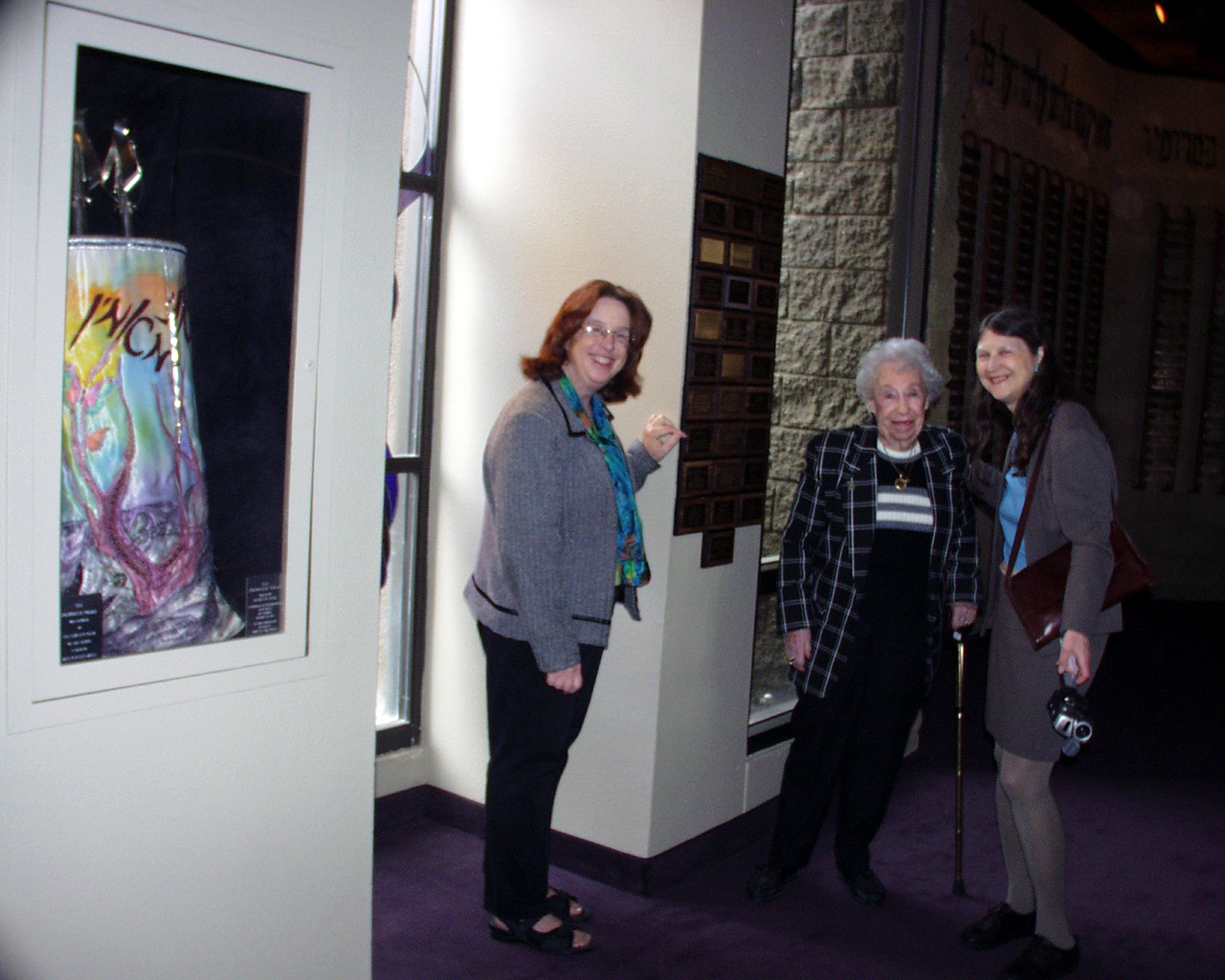 Next
we traveled to the San Carlos section of San Diego to Tifereth
Israel Synagogue, the Conservative congregation where Gerstle is a member.
As Lottmann-Kaeseler's videotape rolled, the synagogue's executive director,
Regina Wurst, showed us through the sanctuary where another Holocaust Torah is
the centerpiece of a display in which plaques memorialize the murdered families
of Gerstle and other members of the New Life Club. That club of Holocaust
Survivors meets monthly. Originally having more than 120 members, the club
has been "shrinking," because many members are elderly, Gerstle noted. Next
we traveled to the San Carlos section of San Diego to Tifereth
Israel Synagogue, the Conservative congregation where Gerstle is a member.
As Lottmann-Kaeseler's videotape rolled, the synagogue's executive director,
Regina Wurst, showed us through the sanctuary where another Holocaust Torah is
the centerpiece of a display in which plaques memorialize the murdered families
of Gerstle and other members of the New Life Club. That club of Holocaust
Survivors meets monthly. Originally having more than 120 members, the club
has been "shrinking," because many members are elderly, Gerstle noted.
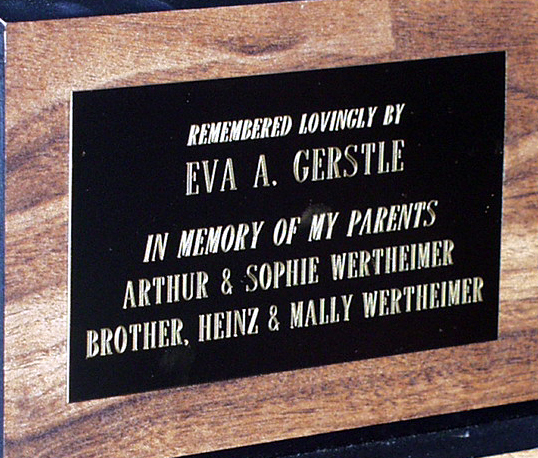 The
mantle of the Holocaust Torah, created by textile artist Jacqueline
Jacobs, was
inspired by "The Butterfly," a well-known poem from Terezin written
by Pavel Friedman which said among the sights one never gets to see in the
ghetto is a butterfly. Jacobs' mantle shows a barbed wire on which a butterfly
is trapped, a symbol of the Holocaust. Above, butterflies flying in the bright
sunlight represent liberation and freedom. The Hebrew inscription on the
Torah mantle is Ani Ma'anim, "I believe," which is considered
an anthem by some Survivors, expressing the belief that even though God may
tarry, He still is with us. The
mantle of the Holocaust Torah, created by textile artist Jacqueline
Jacobs, was
inspired by "The Butterfly," a well-known poem from Terezin written
by Pavel Friedman which said among the sights one never gets to see in the
ghetto is a butterfly. Jacobs' mantle shows a barbed wire on which a butterfly
is trapped, a symbol of the Holocaust. Above, butterflies flying in the bright
sunlight represent liberation and freedom. The Hebrew inscription on the
Torah mantle is Ani Ma'anim, "I believe," which is considered
an anthem by some Survivors, expressing the belief that even though God may
tarry, He still is with us.
Our discussion about Lottmann-Kaeseler's mother never wanting to talk about the
Holocaust prompted Gerstle to disclose while we drove from one synagogue to the
other that she, too, had not wanted to talk with her children about her life at
Terezin and later at the Auschwitz and Stutthof camps.
She disclosed that she used to wear a bandage over the Auschwitz tattoo on her
arm because people in grocery stores, not knowing what the numbers represented,
would inquire if that were her telephone number. One night, she said, her
teenage daughter, Susi, burst into the bedroom of herself and her late
husband, Julius Gerstle, and was in tears after returning from a date with a
boy. The daughter was so distraught she could not tell her parents what was the
matter, but promised to talk with them the next morning. Gerstle recalled that
she could not sleep that night, so worried was she that something terrible might
have happened to her daughter on her date.
It turned out that Susi and her escort had gone to see the movie, The
Pawnbroker, which in 1964 was one of the first to portray what had happened
in the camps. Susi wanted to know if this was what had happened to Gerstle and
to her first husband, Ari Zwick. At that point, Gerstle realized it was time to
tell the story of her experiences in the camps, and of her return in 1946 to
Wiesbaden to search in vain for members of her family. It was in
Wiesbaden, which then was in the American Occupation Zone, that she met Julius
Gerstle, an American soldier encamped nearby. The story of Gerstle's experiences
was so difficult for Susi to listen to, that she protectively urged her mother,
"don't tell Jackie," her sister, who is three years younger.
After
that emotional experience, talking about the Holocaust gradually became easier
for Gerstle, who thereafter spoke to schoolchildren in the United States—helping
to spread understanding of the Holocaust A movement in Wiesbaden to
grapple with its past led to an invitation to Gerstle from the officials of that
city to return for a visit. She returned several times to her home town as
a lecturer.
Lottmann-Kaeseler lived in Kent, Ohio, for a year as a high school exchange
student, and speaks English with very little accent. She said she also had
as a gymnastics teacher in Essen, Germany, a remarkable Jewish woman who had hidden
through the Holocaust and who spoke freely to her students about her experiences
and about her family in Israel. "She taught us Hebrew songs,"
Lottmann-Kaeseler recalled.
Trained as a legal researcher, Lottmann-Kaeseler became fascinated by the Jewish
world in its many aspects, not just the Holocaust. She has traveled to
Israel, spent time on a kibbutz, participated in Wiesbaden-Kfar Saba sister city
events and, as the museum's chairperson, has overseen exhibitions on various
facets of the Jewish experience, including the lives and works of well-known
Jewish authors.
I mentioned to Lottmann-Kaeseler that mystery writer Faye
Kellerman recently had spoken at the Lawrence Family JCC and had commented
that seeing the many monuments in Germany to the Holocaust had prompted
mixed emotions. She was pleased that the Germans will not forget, but at
the same time wondered if its right to constantly make Germans feel guilty.
Lottmann-Kaeseler commented that German history "will be burdened with this
forever," and that the world's memory of the Holocaust is not
something that ever will go away. It is important for German society to ask
itself "how is it possible that people can do this?" and "what
was the makeup of German society that made it possible?" These will
always be important questions, she said. In facing up to their past,
Germans draw lessons that will impact their future.
|

